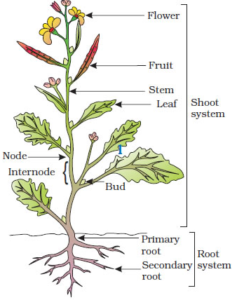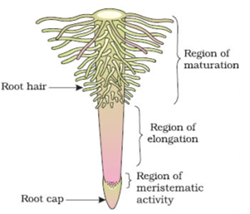Science > Biology > Botany > Morphology of Plants > The Root
In this article, we shall study morphology of root, different regions of root, and different types of roots.
Morphology:
Morphology is a branch of biology dealing with the study of the form and structure of organisms and their specific structural features
Importance of Morphology:
- Knowledge of morphology is essential for the recognition or identification of organism.
- It is an important criterion for the classification of organisms.
- It gives information about the range of variations found in a species.
- Knowledge of morphology is required for studying various aspects of plant life like anatomy, physiology, genetics, ecology, etc.
- Deficiency and toxicity symptoms are morphological changes that occur in response to a shortage or excess of minerals.
- It forms the basis for breeding experiments.
- It helps in deciding methods of food processing and preservation.
- An ecological study of adaptation by the organism to the environment is studied using morphology.
Morphology of Flowering Plant:
The body of a typical flowering plant can be divided into the underground root system and aerial shoot system. The root system is homogeneous and consists of the main root and its lateral branches. The shoot system is heterogeneous and consists of stem, branches, leaves, and flowers. The parts of the plant body which are mainly concerned with important functions of nutrition and growth are called vegetative parts. e.g. root, stem, and leaves. The parts which perform the function of sexual reproduction are called floral or reproductive parts. e.g. flower.

The Root System:
The root system is the descending (growing downwards) portion of the plant axis. When a seed germinates, the radicle is the first organ to come out of it. It elongates to form the primary or the taproot. It gives off lateral branches (secondary and tertiary roots) and thus forms the root-system.
Characteristics of Roots:
- The root develops from the radicle of the embryo present in the seed.
- They are cylindrical generally non-green structures.
- They are homogeneous because they produce similar organs such as secondary and tertiary roots from the pericycle. i.e. they are endogenous.
- They are not differentiated into nodes and internodes.
- They do not produce dissimilar organs like leaves, buds.
- They are positively geotropic (moves towards the soil), positively hydrotropic (moves towards the water) and negatively phototropic (moves away from the light).
- Generally, they are non-green and cannot synthesize food.
- The apex of the root is sub-terminal; because its tip is protected by a thimble-like structure called the root cap.
- It bears lateral rootlets which are always endogenous in origin.
- Root hairs are present near the tip of finer branches of root to increase the surface area of absorption of water and minerals.
Functions of Root:
- Its main functions are the absorption of water and minerals from the soil.
- It provides a proper anchorage to the plant parts.
- It transport absorbed water and minerals to the stem through the xylem.
- Storing reserve food material and synthesis of plant growth regulators are its other functions.
- By undergoing modifications in their structure, roots perform special physiological functions like food storage, assimilation, absorption of atmospheric moisture, sucking food from the host, better gaseous exchange and mechanical functions like floating (buoyancy), stronger anchorage and climbing.
Regions of the Root:

Root Cap Region:
The root is covered at the apex by a thimble-like structure called the root cap (Calyptra). It is produced by a meristematic zone. It protects the tender apex of the root as it makes its way through the soil. The cells of root cap secret mucilage which lubricates the passage of the root through soil. Mucilage also helps in the absorption of water and uptake of nutrient ions. Multiple root caps are present in pandanus (Screwpine). As the root grows further down in the soil, root cap wears out but it is constantly renewed. In aquatic plants like Pistia and water hyacinth (Eichornia)(जल कुंभी) root cap is like a loose thimble, called root pocket.
The Region of Meristematic Cells or Region of Cell Division:
Meristematic means rapid increasing or rapid growth. A few millimetres above the root cap is the region of meristematic activity. The cells of this region are very small, thin-walled and with a dense protoplasm and divide actively. In monocots, the root cap is formed by the independent group of cells known as Calyptrogen. The apical meristem consists of :
- Dermatogen (outermost layer whose cells mature into epiblema and root cap);
- Periblem (inner to dermatogen whose cells mature into cortex) and
- Plerome (the central region whose cells mature into stele).

The Region of Elongation:
The cells proximal to this region undergo rapid elongation and enlargement and are responsible for the growth of the root in length. This region is called the region of elongation.
The Region of Maturation:
The cells of the elongation zone gradually differentiate and mature. Hence, this zone, proximal to the region of elongation, is called the region of maturation. Matured cells differentiate into various tissues like root hairs and permanent region.
From this region some of the epidermal cells form very fine and delicate, thread-like structures called root hairs. This region is called the piliferous region. The root hairs are elongated, single-celled tubular structures that remain in contact with soil particles. The root hairs increase the surface area of absorption. Root hairs are short-lived and are replaced every 10 to 15 days. These root hairs absorb water and minerals from the soil.
The permanent region (zone of differentiated cells) lies behind the root hair zone and is without hairs. It produces lateral roots, anchors the plant in soil and conducts water and minerals upwards. The enlarged cells in this region undergo differentiation to form different types of primary root tissues like cortex, endodermis, xylem, phloem, etc.
Types of Root System:
Taproot System:

In a majority of the dicotyledonous plants, the direct elongation of the radicle leads to the formation of the primary root which grows in the soil. It gives off lateral branches (secondary and tertiary roots) and thus forms the taproot system. All lateral branches are produced in acropetal succession, i.e. the older and longer branches are near the base and younger and shorter ones are near the apex of the main root. The primary roots and its branches constitute the taproot system. Taproot system is the characteristics of most of the dicots. e.g. roots in the mustard (Brassica) (सरसों), sunflower (Helianthus) (सूरजमुखी) plant.
This system of roots provides a very strong anchorage as they are able to reach very deep into the soil. The deep feeder root system is also called the racemose taproot system. In some plants, the taproot remains short but the secondary roots grow horizontally to large extend along the surface of the soil and do not penetrate deep in the soil. such roots are called surface feeders.
Characteristics of Tap Root System:
- It develops from the radicle of the embryo.
- It is always underground.
- There is one main root with branches arising in an acropetal manner.
- The main or primary root persists throughout the life of the plant.
- These roots penetrate deep into the soil. Hence they act as a deep feeder.
Adventitious or Fibrous Root System:

In monocotyledonous plants, the primary root is short-lived and is replaced by a large number of roots. A cluster of slender, fibre-like roots arises from the base of the radicle and plumule which constitute the fibrous system of roots. e.g. roots in wheat (गेहूँ), maize (मक्का), sugarcane (गन्ना). In some plants, like grass (घास), Monstera (a tropical American vine having roots that hang like cords and cylindrical fruit with a pineapple and banana flavour) and the banyan (बरगद) tree, roots arise from parts of the plant other than the radicle and are called adventitious roots. Such roots can develop from the base of stem, nodes or from leaves. They do not branch profusely, are shallow and spread horizontally, do not grow deep in the soil, hence cannot provide strong anchorage to the plant.
Characteristics of Adventitious Root System:
- It may arise from any part of the plant except radicle.
- It may be underground or aerial.
- Many roots arise in clusters of the same size.
- The primary root is short-lived and in plant’s life, it is replaced by adventitious roots.
- These do not penetrate deep in the soil.
Note:
Some aquatic plants like Utricularia, Wolfia, Ceratrophyllum, Myriophyllum, and Lemna do not have roots. Their submerged parts perform the functions of the root.
5 replies on “The Root”
I have really learnt a lot today , everything I wanted to see I found it and it was nothing but the best.
I really enjoy botany today and that’s what life need. It deserve nothing more than the best
Really very good information,everything is useful,absolutely this is what a student wants…👍🏽👍🏽👌👌👌😘
Thank you so much 💗
I’m very excited, everything is useful, that’s what students wants